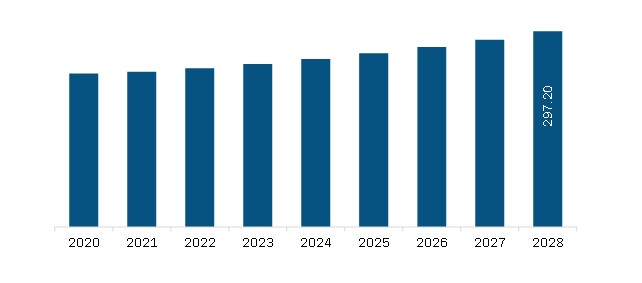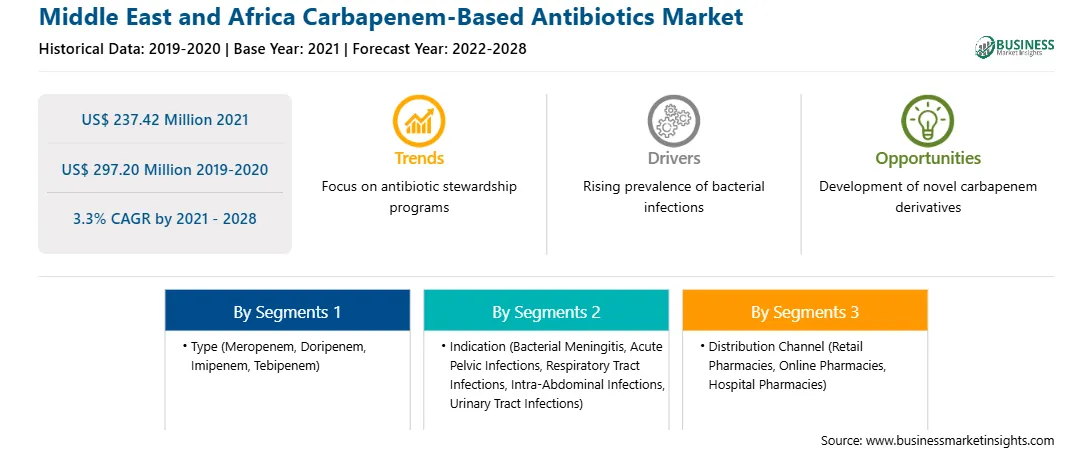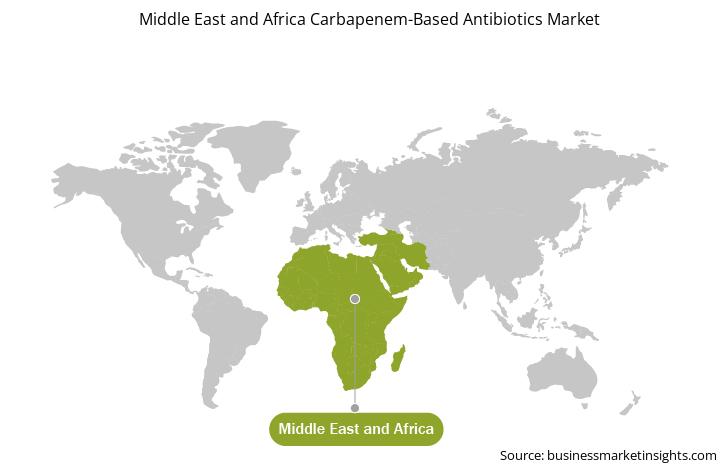The Middle East and Africa carbapenem-based antibiotics market is expected to reach US$ 297.20 million by 2028 from US$ 237.42 million in 2021; it is estimated to grow at a CAGR of 3.3% from 2021-2028.
The market's growth is attributed to factors such as the rising prevalence of bacterial infections and increasing private and public partnerships of leading pharmaceutical players. However, the tedious and expensive process of developing antibiotics is expected to restrain the market's growth during the forecast period.
Technological developments in the pharmaceutical industry led to drastic evolution and better treatment. The pharmaceutical industry has incorporated intelligent technologies such as deep learning, artificial intelligence (AI), and machine learning to develop new antibiotics. Researchers are working to establish tools and platforms for identifying new antibiotics. It is expected that the novel technologies in new antibiotic discoveries are supposed to change the overall antibiotics market. However, developing antibiotics for gram-negative bacteria is challenging, as various drugs are still developing.
The major challenge for the development of antibiotics is the limited permeability of molecules across the bacterial envelope. However, gram-negative bacteria have nutrient-specific protein channels (porins) that restrict the permeability of non-essential molecules, including antibiotics. Permeability has allowed researchers to develop a new platform called computational antibiotic screening (CLASP), which helps identify potential drug molecules through porins.
CLASP has the advantage of coarse grain (CG) resolution, advanced sampling techniques, and a parallel computing environment that maximizes its performance. It provides complete thermodynamic and kinetic results of a potential drug molecule under study in a few hours. It helps in understanding or identifying small molecule libraries that yield structure-property relationships to discover antibiotics with high permeability. Thus, it is expected that CLASP will accelerate the new antibiotic drug for gram-negative bacterial infections, thus further leading to significant market growth.
Also, generic versions are popular due to their availability and affordability. In addition, the expiry of patented carbapenem-based antibiotics has widen-up opportunities for generic drug manufacturers to enter the market with their cost-efficient drugs. As a result, companies are accelerating generic drug production and driving the Middle East carbapenem-based antibiotics market.

Strategic insights for the Middle East and Africa Carbapenem-Based Antibiotics provides data-driven analysis of the industry landscape, including current trends, key players, and regional nuances. These insights offer actionable recommendations, enabling readers to differentiate themselves from competitors by identifying untapped segments or developing unique value propositions. Leveraging data analytics, these insights help industry players anticipate the market shifts, whether investors, manufacturers, or other stakeholders. A future-oriented perspective is essential, helping stakeholders anticipate market shifts and position themselves for long-term success in this dynamic region. Ultimately, effective strategic insights empower readers to make informed decisions that drive profitability and achieve their business objectives within the market.

| Report Attribute | Details |
|---|---|
| Market size in 2021 | US$ 237.42 Million |
| Market Size by 2028 | US$ 297.20 Million |
| Global CAGR (2021 - 2028) | 3.3% |
| Historical Data | 2019-2020 |
| Forecast period | 2022-2028 |
| Segments Covered |
By Type
|
| Regions and Countries Covered | Middle East and Africa
|
| Market leaders and key company profiles |
The geographic scope of the Middle East and Africa Carbapenem-Based Antibiotics refers to the specific areas in which a business operates and competes. Understanding local distinctions, such as diverse consumer preferences (e.g., demand for specific plug types or battery backup durations), varying economic conditions, and regulatory environments, is crucial for tailoring strategies to specific markets. Businesses can expand their reach by identifying underserved areas or adapting their offerings to meet local demands. A clear market focus allows for more effective resource allocation, targeted marketing campaigns, and better positioning against local competitors, ultimately driving growth in those targeted areas.

The Middle East and Africa Carbapenem-Based Antibiotics Market is valued at US$ 237.42 Million in 2021, it is projected to reach US$ 297.20 Million by 2028.
As per our report Middle East and Africa Carbapenem-Based Antibiotics Market, the market size is valued at US$ 237.42 Million in 2021, projecting it to reach US$ 297.20 Million by 2028. This translates to a CAGR of approximately 3.3% during the forecast period.
The Middle East and Africa Carbapenem-Based Antibiotics Market report typically cover these key segments-
The historic period, base year, and forecast period can vary slightly depending on the specific market research report. However, for the Middle East and Africa Carbapenem-Based Antibiotics Market report:
The Middle East and Africa Carbapenem-Based Antibiotics Market is populated by several key players, each contributing to its growth and innovation. Some of the major players include:
The Middle East and Africa Carbapenem-Based Antibiotics Market report is valuable for diverse stakeholders, including:
Essentially, anyone involved in or considering involvement in the Middle East and Africa Carbapenem-Based Antibiotics Market value chain can benefit from the information contained in a comprehensive market report.